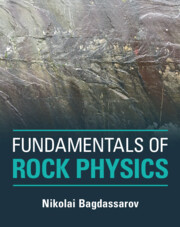Book contents
- Fundamentals of Rock Physics
- Fundamentals of Rock Physics
- Copyright page
- Dedication
- Contents
- Preface
- 1 Introduction
- 2 Density and Porosity
- 3 Stresses in Rocks
- 4 Mechanical Strain and Elastic Moduli
- 5 Permeability of Rocks
- 6 Mechanical Properties of Fluid-Bearing Rocks
- 7 Acoustic Properties of Rocks
- 8 Electric Resistivity
- 9 Dielectric Properties
- 10 Magnetic Properties of Rocks
- 11 Thermal Properties of Rocks and Minerals
- 12 Radioactive Properties of Rocks
- Index
- References
4 - Mechanical Strain and Elastic Moduli
Published online by Cambridge University Press: 19 November 2021
- Fundamentals of Rock Physics
- Fundamentals of Rock Physics
- Copyright page
- Dedication
- Contents
- Preface
- 1 Introduction
- 2 Density and Porosity
- 3 Stresses in Rocks
- 4 Mechanical Strain and Elastic Moduli
- 5 Permeability of Rocks
- 6 Mechanical Properties of Fluid-Bearing Rocks
- 7 Acoustic Properties of Rocks
- 8 Electric Resistivity
- 9 Dielectric Properties
- 10 Magnetic Properties of Rocks
- 11 Thermal Properties of Rocks and Minerals
- 12 Radioactive Properties of Rocks
- Index
- References
Summary
From stress-strain curves the tangential, average and secant elastic moduli can be estimated. Elastic moduli of solids have an atomistic background. Strain tensor is defined in matrix form, the elements of which represent relative deformations in respect of coordinate system axis and planes. The Poisson’s ratio ν in anisotropic rocks varies depending on the symmetry of spacing. The Poisson ratio depends on porosity, geometry of porous space, and their saturation. Hooke’s law establishes the linear relationship between the elements of stress and strain matrices. Taylor’s and Sack’s “homogenization” models are used to calculate effective elastic moduli. The averaging procedure after Voigt, Reuss, upper-lower bounds of Hashin–Shtrikman, direct and self-consistent methods and statistical continuum approach are used for calculations of elastic constants. Elastic moduli of rocks depend on pressure, temperature and porosity. Plasticity and viscous behavior may effectively be described by a combination of standard bodies: elastic springs, viscous dashpots, Saint-Venant friction and rupture elements. Their combinations connected in parallel and sequence may describe ductility and progressive failure. Friction in rocks depends on strain rate and the state of sliding contact after the Dietrich–Ruina law. Focus Box 4.1: Poisson’s ratio and crystal anisotropy.
Keywords
- Type
- Chapter
- Information
- Fundamentals of Rock Physics , pp. 113 - 177Publisher: Cambridge University PressPrint publication year: 2021



